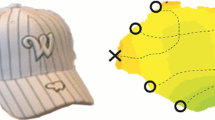Abstract
The topological active volumes is an active model focused on 3D segmentation tasks. It is based on the 2D Topological Active Nets model and provides information about the surfaces and the inside of the detected objects in the scene. This paper proposes new optimization approaches based on genetic algorithms that improve the results of the 3D segmentations and overcome some drawbacks of the model related to parameter tuning or noise conditions. The hybridization of the genetic algorithm with a greedy local search allows the treatment of topological changes in the model, with the possibility of an automatic subdivision of the topological active volume. This combination integrates the advantages of the global and local search procedures in the segmentation process.

















Similar content being viewed by others
References
Ansia F, Penedo M, Mariño C, Mosquera A (1999) A new approach to active nets. Pattern Recognit Image Anal 2:76–77
Ballerini L (1999) Medical image segmentation using genetic snakes. In: Proceedings of SPIE: application and science of neural networks, fuzzy systems, and evolutionary computation II, vol 3812, pp 13–23
Barreira N, Penedo MG (2005) Topological active volumes. EURASIP J Appl Signal Process 13(1):1937–1947
Bro-Nielsen M (1994) Active nets and cubes. Technical report 13. IMM, Technical University of Denmark
Bro-Nielsen M (1995) Modelling elasticity in solids using active cubes—application to simulated operations. In: Proceedings of the first international conference on computer vision, virtual reality and robotics in medicine. Lecture notes in computer science, vol 905, pp 533–541
Fan Y, Jiang T, Evans D (2002) Volumetric segmentation of brain images using parallel genetic algorithms. IEEE Trans Med Imaging 21(8):904–909
Goldberg D (1989) Genetic algorithms in search, optimization and machine learning. Addison-Wesley Longman Publishing Co Inc, Boston
Heimann T, Münzing S, Meinzer HP, Wolf I (2007) A shape-guided deformable model with evolutionary algorithm initialization for 3D soft tissue segmentation. In: Karssemeijer N, Lelieveldt B (eds) IPMI 2007. Lecture notes in computer science, vol 4584. Springer, Berlin, pp 1–12
Ibáñez O, Barreira N, Santos J, Penedo M (2009) Genetic approaches for topological active nets optimization. Pattern Recognit 42:907–917
Jones TN, Metaxas DN (1997) Automated 3D segmentation using deformable models and fuzzy affinity. In: Proceedings of the 15th international conference on information processing in medical imaging. Lecture notes in computer science, vol 1230, pp 113–126
Kass M, Witkin A, Terzopoulos D (1988) Snakes: active contour models. Int J Comput Vision 1(2):321–323
MacEachern L, Manku T (1998) Genetic algorithms for active contour optimization. In: Proceedings of IEEE international symposium on circuits and systems, vol 4, pp 229–232
McInerney T, Terzopoulos D (1999) Topology adaptive deformable surfaces for medical image volume segmentation. IEEE Trans Med Imaging 18(10):840–850
Ooi C, Liatsis P (2001) Co-evolutionary-based active contour models in tracking of moving obstacles. In: International conference on advanced driver assistance systems, pp 58–62
Qiu B, Clarysse P, Montagnat J, Janier M, Vray D (2004) Comparison of 3D deformable models for in vivo measurements of mouse embryo from 3D ultrasound images. In: Ultrasonics symposium, 2004 IEEE, vol 1, pp 748–751
Santos J, Ibáñez O, Barreira N, Penedo M (2007) Genetic-greedy hybrid approach for topological active nets optimization. In: Adaptive and natural computing algorithms. Lecture notes in computer science, vol 4431, pp 202–210
Séguier R, Cladel N (2003) Genetic snakes: application on lipreading. In: International conference on artificial neural networks and genetic algorithms. p 29
Tanatipanond T, Covavisaruch N (1999) An improvement of multiscale approach to deformable contour for brain MR images by genetic algorithm. In: The 1999 international symposium on intelligent signal processing and communication system, pp 677–680
Tsumiyama K, Yamamoto K (1989) Active net: active net model for region extraction. IPSJ SIG notes 89(96):1–8
Acknowledgements
This paper was funded by the Ministry of Science and Innovation of Spain through project TIN2007-64330 and by the Instituto de Salud Carlos III through the grant contract PI08/90420 using FEDER funds.
Author information
Authors and Affiliations
Corresponding author
Rights and permissions
About this article
Cite this article
Novo, J., Barreira, N., Penedo, M.G. et al. Topological active volume 3D segmentation model optimized with genetic approaches. Nat Comput (2011). https://doi.org/10.1007/s11047-011-9261-1
Received:
Accepted:
Published:
DOI: https://doi.org/10.1007/s11047-011-9261-1




